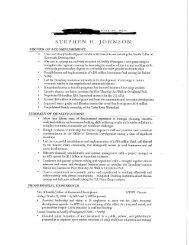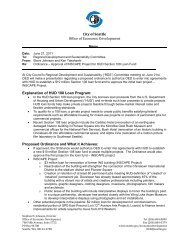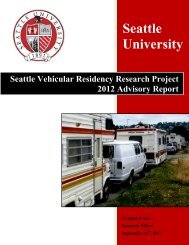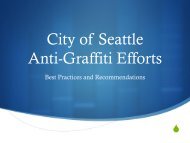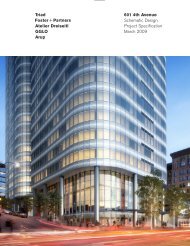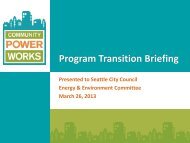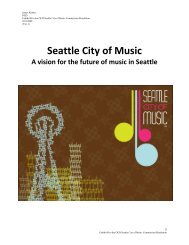2013 Water System Plan, Volume II - Seattle City Clerk's Office - City ...
2013 Water System Plan, Volume II - Seattle City Clerk's Office - City ...
2013 Water System Plan, Volume II - Seattle City Clerk's Office - City ...
You also want an ePaper? Increase the reach of your titles
YUMPU automatically turns print PDFs into web optimized ePapers that Google loves.
Chapter 18 <strong>Plan</strong> Review<br />
Organization<br />
Branch<br />
SPU Solid Waste<br />
Division<br />
SPU Survey<br />
SPU Field Operations<br />
and Maintenance<br />
Branch<br />
SPU Utility <strong>System</strong>s<br />
Management Branch<br />
(USM)<br />
Involvement<br />
billing.<br />
Reviews detailed plans to assure new construction allows for safe access to solid waste<br />
containers by property owners, citizens, and waste disposal employees and vehicles.<br />
Reviews plans for work in the ROW to protect <strong>City</strong> property. SPU Survey may also<br />
conduct or review surveys for SPU or other <strong>City</strong> projects.<br />
Reviews plans to ensure that installed improvements can be operated and maintained using<br />
standard procedures. Reviews to ensure that planned improvements will not negatively<br />
affect the ability to operate and maintain existing SPU facilities. Coordinates plans and<br />
construction by SPU crews.<br />
Advises on complex policy issues that are escalated by SPU PMED.<br />
18.3 TYPES OF PLAN REVIEW<br />
The SPU PMED Division is involved in four general types of plan review: private development,<br />
CIP projects, other agency projects, and property-related reviews. The degree of SPU<br />
involvement may vary greatly depending on type of permit and project specifics.<br />
18.3.1 Private Development Projects<br />
Private development refers to projects that are constructed by private parties and modify, build,<br />
or impact public water, stormwater, wastewater, or solid waste systems. The SMC regulates<br />
private development and requires development permits for most private development.<br />
Examples of private development include a new commercial building, subdivision of property,<br />
or redevelopment of a block.<br />
<strong>City</strong> of <strong>Seattle</strong> development permitting is organized into two primary categories (Figure 18-1):<br />
Parcel. This development or redevelopment is on private property either owned by a<br />
private party or a public agency. DPD manages parcel based permitting through the<br />
Master Use, Building, and Side Sewer Permits and the plans are reviewed, approved,<br />
and inspected through the DPD permit process.<br />
Right-of-Way (ROW). This development or redevelopment is within the public ROW.<br />
SDOT manages ROW permitting through its Street Use Permit Process.<br />
Infrastructure review is managed by SDOT, however SPU <strong>Plan</strong> Review staff has an<br />
active role in the 30%, 60% and 90% design phases, as well as preliminary design<br />
guidance. ROW work can be conducted by a variety of entities including SDOT, SPU,<br />
SCL, Franchise Utilities, and private developers.<br />
As shown on Figure 18-1, some permits may cross boundaries. For example, a Side Sewer Permit<br />
(a type of construction permit) is issued by DPD, although part of the permitted work occurs in<br />
the ROW. Similarly, permitting issues may cross boundaries because drainage or wastewater<br />
discharges from developed parcels can impact adjacent wetlands or SPU infrastructure.<br />
SPU Design Standards and Guidelines 18-3



